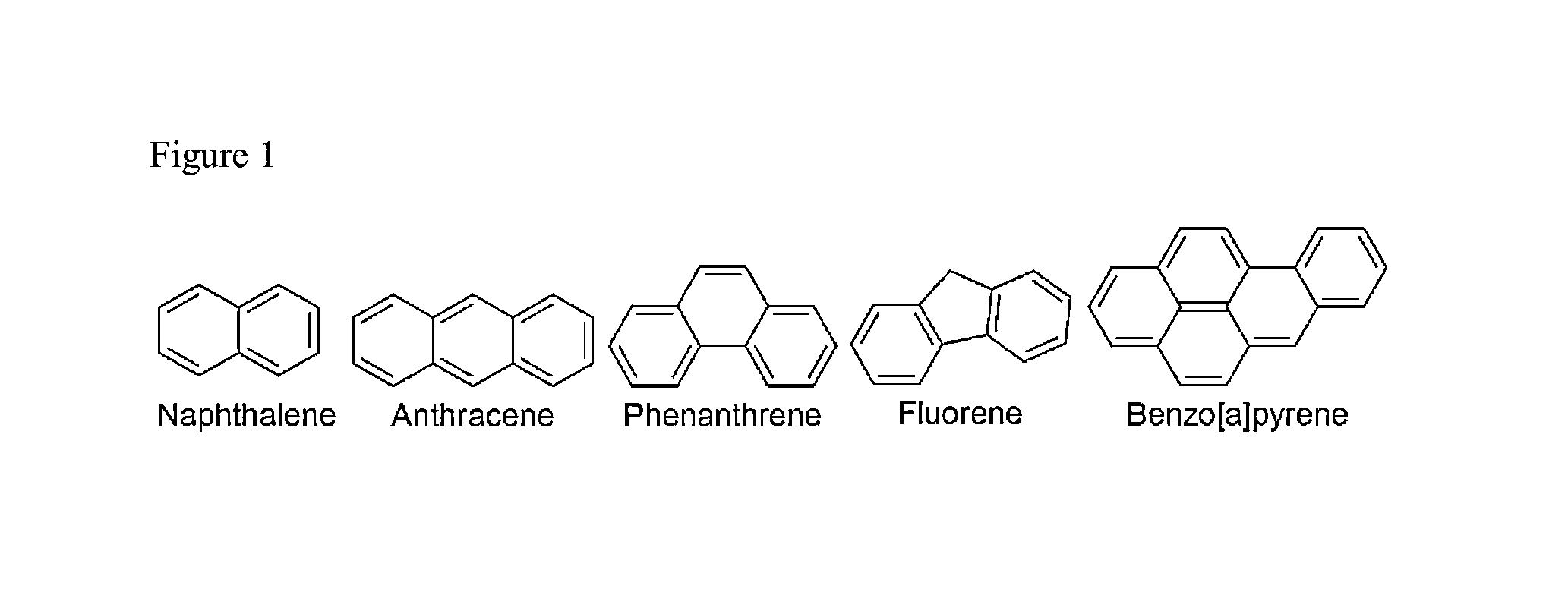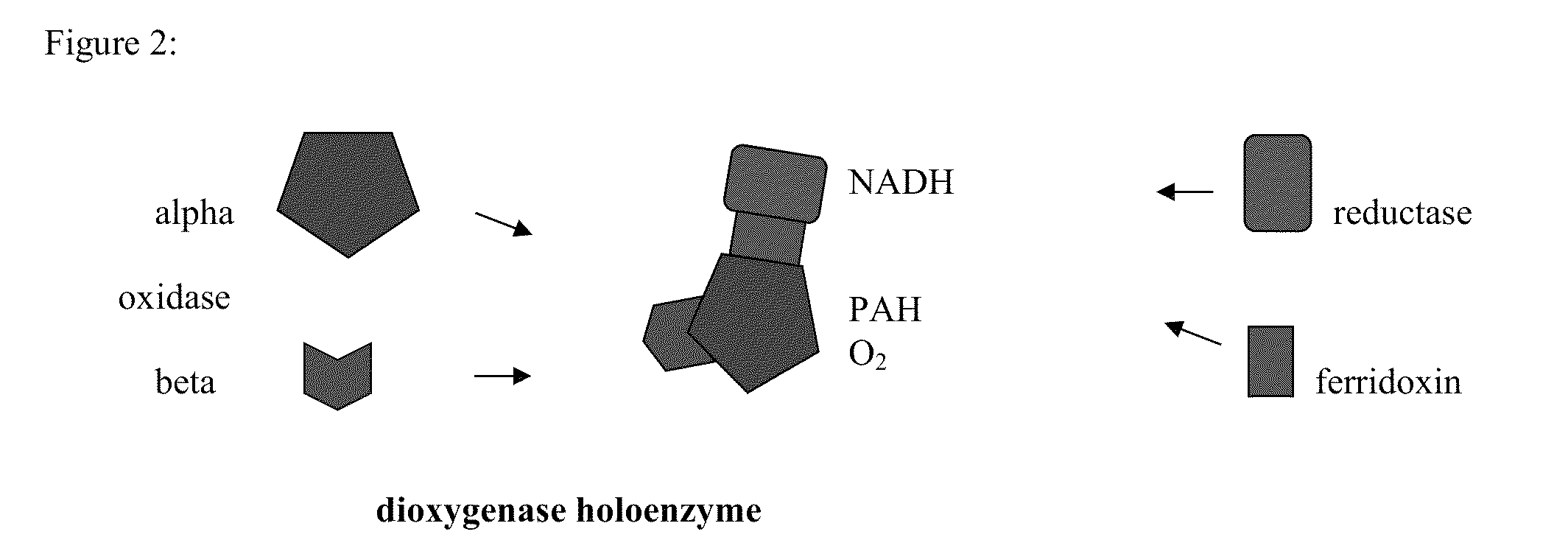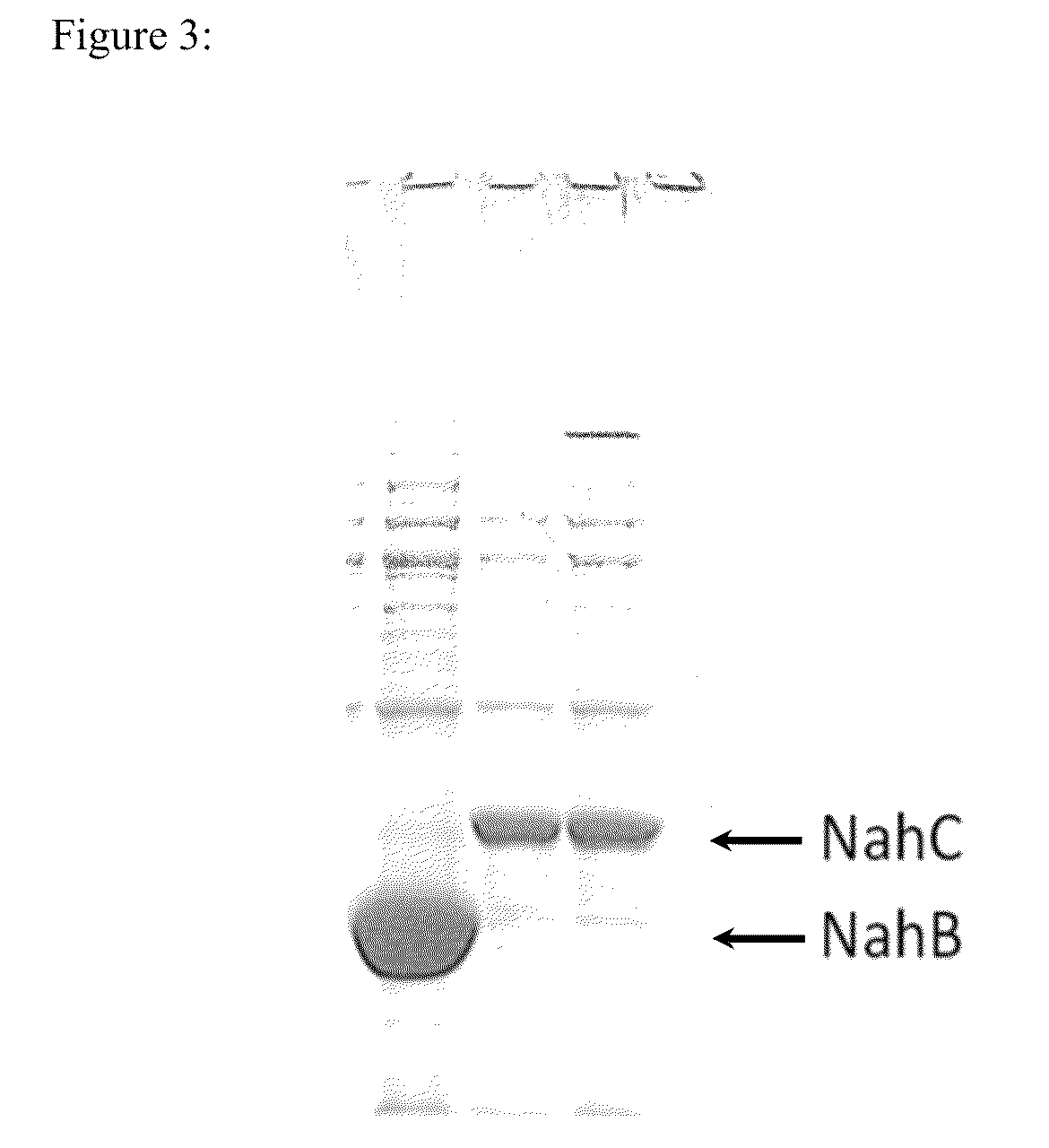Method of detecting the presence of polycyclic aromatic hydrocarbons
a technology of aromatic hydrocarbons and detection methods, applied in the field of detection of aromatic hydrocarbons, can solve the problems of lingering threat to aquatic life and seafood over vast areas, large environmental and human health threats, and rapid spread of spilled petroleum through the sea to contaminate large marine areas, so as to prevent the loss of activity
- Summary
- Abstract
- Description
- Claims
- Application Information
AI Technical Summary
Benefits of technology
Problems solved by technology
Method used
Image
Examples
example 1
Production of Recombinant Napthalene Dioxygenase
[0040]Naphthalene dioxygenase (NDO) was expressed in the E. coli strain JM109 (DE3) (PDTG141). This strain harbors a plasmid which can produce all four subunits of the enzyme. These cells were grown in RI medium with 0.1 mM thiamine, 25 mg / l ampicillin at 30° C. and 300 rpm until reaching an OD of 0.5 at 600 nm. Cultures were induced with a final concentration of 0.1 mM IPTG and 0.0003% NH4FeSO4 and shaken at 30° C.
[0041]NDO cultures were harvested 4 hours after induction with IPTG. Cultures were decanted into spin tubes and centrifuged for 15 minutes at 4500 rpm and 4° C. After centrifugation the media was decanted from the cells and the cell pellets were frozen at −20° C. overnight.
[0042]Frozen cell pellets were thawed on ice and resuspended in lysis buffer (50 mM Tris-Cl pH 7, 5% glycerol, 1 mM dithiothreitol and 0.2 mg / ml lysozyme) at a ratio of 1:20 (lysis buffer:culture volume) and allowed to lyse on ice for 1 hour. Two microlite...
example 2
Production of Recombinant NahB and NahC Enzymes
[0044]Expression plasmids containing the genes encoding the NahB and NahC enzymes were transformed into E. coli BL21 Star (DE3). These transformations were used to induce overnight serial dilutions at 37 C. The log phase cultures from the serial dilution were used to inoculate 37° C. growth cultures in Rich Induction medium (20 g / l tryptone, 10 g / l yeast extract, 5 g / l NaCl). These cultures were induced at OD 1 using 1 mM IPTG; the cultures were induced at 18° C. for 18 hours. Cultures were decanted into spin tubes and centrifuged for 15 min at 4500 rpm and 4° C. After centrifugation cell pellets were immediately lysed with NahB (20 mM KH2PO4 pH 7.2, 1 mM dithiothreitol, 0.4% Triton X-100) or NahC (20 mM KH2PO4 pH 6.2, 1 mM dithiothreitol, 0.4% Triton X-100) lysis buffer respectively at a ratio of 1:20 (lysis buffer:culture volume). One microliter of benzonase was added to each sample to reduce viscosity; the samples were centrifuged at...
example 3
Colorimetric Detection of Naphthalene Using a Coupled Naphthalene Dioxygenase / NahB / NahC Assay
[0045]2 tubes each of NahB, Nahc, and NDO enzymes (1.7 ml aliquotes) were thawed from −20 C along with 2.6 mM NADH in water. 2.5 ml each of the NahC and NahB enzymes were desalted using PD-10 gel filtration and buffer exchanged into 20 mM Tris-Cl pH 8.5 at the same time. Once all of the reagents were thawed and desalted, positive and negative naphthalene reaction were made containing 127 ul each of NahB, NahC, and NDO with 20 ppm naphthalene in dimethylformamide (negative reactions contained only equal amounts dimethylformamide) and 0.133 mM NADH final concentration with a final reaction volume of 405 ul. The reaction was run at 25° C. for 2 hours and the sample absorbance was measured using a BioTek Synergy2 plate reader in the 320-640 nm wavelength range. The reaction containing naphthalene had significantly higher absorbance at 370 nm than the negative control reaction. Reactions for all ...
PUM
| Property | Measurement | Unit |
|---|---|---|
| wavelengths | aaaaa | aaaaa |
| temperature | aaaaa | aaaaa |
| pH | aaaaa | aaaaa |
Abstract
Description
Claims
Application Information
 Login to View More
Login to View More - R&D
- Intellectual Property
- Life Sciences
- Materials
- Tech Scout
- Unparalleled Data Quality
- Higher Quality Content
- 60% Fewer Hallucinations
Browse by: Latest US Patents, China's latest patents, Technical Efficacy Thesaurus, Application Domain, Technology Topic, Popular Technical Reports.
© 2025 PatSnap. All rights reserved.Legal|Privacy policy|Modern Slavery Act Transparency Statement|Sitemap|About US| Contact US: help@patsnap.com



